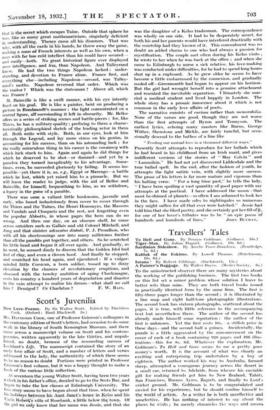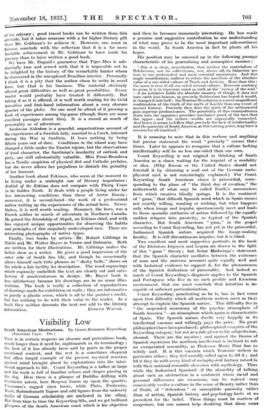Travellers' Tales
7s. 6d.)
Iorana ! By Robert Gibbings. (Duckworth. 15.8.)
A Painter's Baggage. By Walter Bayes. (Medici Society. Os.)
To the uninstructed observer there are many mysteries about. the working of the publishing business. The first two books
on this list set a minor problem whose solution I leave to better wits than mine. They are both travel books issued in practically identical fornt by the same firm. The first is
fifty-three pages longer than the second ; it is illustrated by a line map and eight half-tone photographic illustrations. The second book has sixteen photographs, scattered about the pages, it LS true, with little reference to the accompanying text but nevertheless there. The author of the second has
already made himself some reputation: the author of the first is unknown. Yet the first costs 16s.- --a stiffish price in these days—and the second half a guinea. Incidentally, the puzzle is a little aggravated by the announcement on the cover of each of a book containing 928 pages and 166 illus- trations—this for 8s. 6d. Whatever the explanation, Mr. Goldman's To Hell and Gone scents to me a pretty poor money's worth. It is the account of what was clearly an exciting and enterprising trip undertaken by a boy of eighteen. The author worked his way to Australia, farmed sheep, attempted a courageous journey across the desert in
a small car, returned to Adelaide, from whence his enviable gift for making friends got him to New Zealand, Tahiti, San Francisco, Buenos Ayres, Zagreb, and finally to Lord's cricket . ground. Mr. Goldman is to be congratulated and envied for his experiences, but he should confine himself to the world of action. As a writer he is both unreflective and unselectiVe. He has nothing of interest to say about the places he vizits ; he merely chronicles tke ways and means
of his odyssey; good travel books can be written from this attitude, but it takes someone with a far higher literary gift than Mr. Goldman's to achieve it. However, one must in fairness conclude with the reflection that it is a far more laudable achievement in Mr. Goldman to have made his journey than to have written a good book. We have Mr. Duguid's guarantee that Tiger-Man is sub- stantially true and armed with that it is impossible not to
be delighted by the history of the remarkable hunter whom he discovered in the unexplored Brazilian interior. Personally I think it is a pity that the author chose to write in novel form, but that is his business. The material obviously offered great difficulties as well as great possibilities. Every reader would probably have treated it differently. But taking it as it is offered, it is well worth reading for its vivid narrative and first-hand information about a very obscure quarter of the globe. No one need be afraid of it proving a book of experiences among big-game (though there are some excellent passages about this). It is a record as much of personality as of adventure.
Sardinian Sideshow is a graceful, unpretentious account of the experiences of a Swedish lady, married to a Czech, interned during the War in Sardinia. It loses nothing by being fifteen years out of date. Conditions in the island may have changed a little under the Fascist regime, but the observations of local character, the Sardinian's insularity of outlook and piety, are still substantially valuable. Miss Posse-Brazdova has a Nordic suspicion of physical dirt and Catholic prelates, but she never allows her prejudices to disturb the geniality of her humour.
Another book about Eskimos, who seem at the moment to be living under a midnight sun of literary Importance: Kaiak of the Eskimo does not compare with Thirty Years in the Golden North. It deals with a people living under far less interesting conditions than those of Arctic Russia ; moreover, it is second-hand—the work of a professional author writing up the experiences of the actual hero. Never- theless, it is well worth reading. Romanet, the hero, was a French soldier in' search of adventure in Northern Canada. He gained the friendship of Akpek, an Eskimo chief, and with him enjoyed unique opportunities for observing the habits and principles of this singularly undeveloped race. There are interesting photographs of native types.
Finally, two books by artists—Mr. Robert Gibbings in Tahiti and Mr. Walter Bayes in Venice and Dalmatia. Both arc written for their illustrations. Mr. Gibbings makes the better show as a writer. He gives a good impression of the outer side of South Sea life, and though he occasionally allows himself such trite phrases as "dusky belle," shows on the whole a fair facility for description. The wood engravings which copiously embellish the text are clearly cut and satis- factory if unadventurous in design. Mr. Bayes' book is less satisfactory because his drawings are in no sense illus- trations. The book is really a collection of reproductions of drawings made for exhibition on walls ; they are informative in purely a plastic sense, which is all to the painter's credit, but has nothing to do with their value to the reader. In a book they neither decorate the text nor add to the literary

































































 Previous page
Previous page